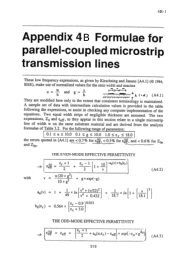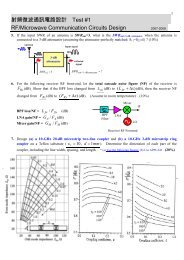You also want an ePaper? Increase the reach of your titles
YUMPU automatically turns print PDFs into web optimized ePapers that Google loves.
5-19<br />
Microstrip Line <strong>Matching</strong> Networks (Ludwig P431)<br />
<br />
In the mid-GHz <strong>and</strong> higher frequency range, the wavelength becomes<br />
sufficiently small <strong>and</strong> the distributed components are widely used. Also, the<br />
discrete R/L/C lumped elements will have more noticeable parasitic effects (see<br />
chapter 2) <strong>and</strong> let to complicating the circuit design process<br />
Distributed componenets (such as transmission line segments) can be used<br />
to mix with lumped elements<br />
From Discrete Components to Microstrip Lines<br />
<br />
Avoid using inductors (if possible) due to higher resistive loss (& higher price)<br />
<br />
<br />
<br />
<br />
<br />
<br />
<br />
<br />
In general, one shunt capacitor & two series transmission lines is<br />
sufficiently to transform any load to any input impedance.<br />
EX: transform load ZL to an input impedance Z in<br />
Z<br />
L 30 j10<br />
<br />
<br />
Zin<br />
60 j80<br />
<br />
f 1.<br />
5 GHz<br />
zL<br />
0.<br />
6 <br />
zin<br />
1.<br />
2 <br />
Identify input & load SWR circles<br />
j0.<br />
2 <br />
Choose A (yA= 1-j0.6) & transform zL to<br />
A by a series TL (l1)<br />
=>Transform A to B (on the input SWR circle)<br />
by a parallel C1<br />
=> Transform B to zin by a series TL (l2)<br />
zL + series-TL (l1)<br />
=> A + shunt C1<br />
=> B + series-TL (l2)<br />
=> zin<br />
j1.<br />
6 <br />
2011-12 H.-R. Chuang EE NCKU





